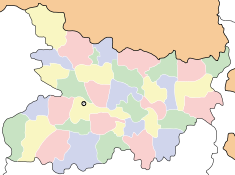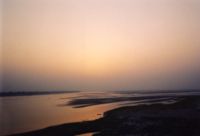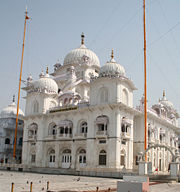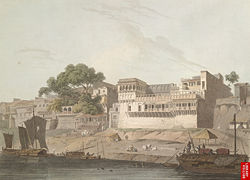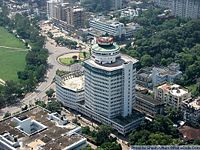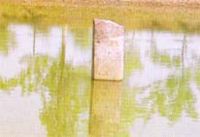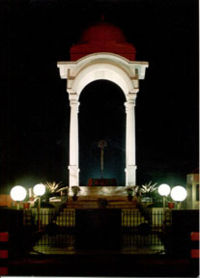Patna
2008/9 Schools Wikipedia Selection. Related subjects: Geography of Asia
| ?Patna Bihar • India |
|
|
|
|
| Coordinates: | |
| Time zone | IST ( UTC+5:30) |
| Area • Elevation |
3,202 km² (1,236 sq mi) • 53 m (174 ft) |
| District(s) | Patna |
| Population • Density |
1,230,000 (2001) • 375 /km² (971 /sq mi) |
| Mayor | GhanShyam Kumar |
| Codes • Pincode • Telephone • UN/LOCODE • Vehicle |
• 800 0xx • +0612 • INPAT • BR-01-? |
Coordinates: Paṭnā pronunciation (Hindi: पटना) is the capital of the Indian state of Bihar, and one of the oldest continuously inhabited places in the world.
The modern city of Patna lies on the southern bank of the Ganges, as it flows past with the combined waters of the rivers Ghagra, Son and Gandak. At the point where the city is located, the sacred Ganges looks more sea than river: mighty, wide and never-ending.This is the only urban area in Bihar which looks like any other modern city of India with good roads and civic system.
A city of 1,800,000 people, the city is approximately 25 km long and 9 km to 10 km wide.
The Hindu and Jain pilgrim centres of Vaishali, Rajgir or Rajgriha, Nalanda, Bodhgaya, and Pawapuri are all nearby. Patna is a sacred city for Sikhs also. The tenth and last "human" guru, Guru Gobind Singh, was born here. It is the ideal gateway for all the places on this circuit. The monuments in and around the city take one down the history to its glorious past.
Apart from being the administrative centre of the state and its historic importance, the city is also a major educational centre and medical centre. It's the epicentre for all the students from Bihar preparing for various competitive examinations. Various educational instituitions are coming up here.
The walled old area, called Patna City by the locals, is also a major trading centre.
Name
The appellation Patna is etymologically derived from Patan, the name of the Hindu goddess, Patan Devi . Another theory says the name comes from Pattan, or a port in Sanskrit since the city, located near the confluence of four rivers, has been a thriving river port.
Another theory suggests that the name Patna may be a short form of Patliputra, one of the most popular ancient names of this city, which is the name that finds mention in the recorded History, dating back to 4th century BD, when Megasthenes (350 BCE-290 BCE), Greek historian, mentions it variously as 'Palibothra' and 'Palimbotra' , later around 4th century, this name also finds mention in the records of Chinese traveller, Fa Hien.
The city has been known by various names during its more than two millennia long existence —Pataligram, Pataliputra, Kusumpur, Pushpapura, and the present day Patna. It received its name of Patna during the reign of Sher Shah Suri, a Bihari ruler who has the distinction of making the only interruption to the long rule of Mughals. His tomb is at Sasaram, a place near to Patna.
History
Legend ascribes the origin of Patna to a mythological King Putraka who created Patna by magic for his queen Patali, literally Trumpet flower, which gives it its ancient name Pataligrama. It is said that in honour of the first born to the queen, the city was named Pataliputra. Gram is the Sanskrit for village and Putra means son.
From a scientific history perspective, it would be appropriate to surmise that the history of Patna started around the year 490 BC when Ajatashatru, the king of Magadh, wanted to shift his capital from the hilly Rajagriha to a more strategically located place to combat the Licchavis of Vaishali. He chose the site on the bank of Ganges and fortified the area. From that time, the city has had a continuous history, a record claimed by few cities in the world. Gautam Buddha passed through this place in the last year of his life, and he had prophesized a great future for this place, but at the same time, he predicted its ruin from flood, fire, and feud.
With the rise of the Mauryan empire, the place became the seat of power and nerve centre of the sub-continent. From Pataliputra, the famed emperor Chandragupta Maurya (a contemporary of Alexander) ruled a vast empire, stretching from the Bay of Bengal to Afghanistan.
Early Mauryan Patliputra was mostly built with wooden structures. Emperor Ashoka, the grandson of Chandragupta Maurya, transformed the wooden capital into a stone construction around 273 BC. Chinese scholar Fa Hein, who visited India sometime around A.D. 399-414, has given a vivid description of the stone structures in his travelogue.
Megasthenes (350 BCE-290 BCE), Greek historian and ambassador to the court of Chandragupta Maurya, gives the first written account of Patliputra. In his book Indika, he mentions that the city of Palibothra (Pataliputra, modern day Patna) was situated on the confluence of the rivers Ganges and Arennovoas (Sonabhadra - Hiranyawah) and was 9 miles long and 1.75 miles wide ,
Much later, a number of Chinese travellers came to India in pursuit of knowledge and recorded their observation about Pataliputra in their travelogues, including those of a Chinese Buddhist Fa Hien, who visited India, between A.D. 399 and 414, and stayed here for many months translating Buddhist texts .
In the years that followed, the city saw many dynasties ruling the Indian subcontinent from here. It saw the rules of the Gupta empire and the Pala kings. However, it never reached the glory that it had under the Mauryas.
With the disintegration of the Gupta empire, Patna passed through uncertain times. Bakhtiar Khilji captured Bihar in the 12th century AD and destroyed many ancient seats of learning, Patna lost its prestige as the political and cultural centre of India.
Guru Gobind Singh (Punjabi: ਗੁਰੂ ਗੋਬਿੰਦ ਸਿੰਘ) (22 December 1666 – 7 October 1708,the tenth Guru of the Sikhs was born as Gobind Rai in Patna to Teg Bahadur, the ninth Guru of the Sikhs, and his wife Gujri. His birth place Harmandir saheb is a one of most sacred pilgrimage for Sikhs.
The Mughal period was a period of unremarkable provincial administration from Delhi. The most remarkable period during these times was under Sher Shah Suri who revived Patna in the middle of the 16th century. He visualised a fort and a town on the banks of Ganga. Sher Shah's fort in Patna does not survive, but the mosque built in Afghan architectural style survives.
Mughal emperor Akbar came to Patna in 1574 to crush the Afghan Chief Daud Khan. Akbar's navratna and state's official historian and author of Ain-i-Akbari Abul Fazl refers to Patna as a flourishing centre for paper, stone and glass industries. He also refers to the high quality of numerous strains of rice grown in Patna famous as Patna rice in Europe.
Mughal Emperor Aurangzeb acceded to the request of his favourite grandson Prince Muhammad Azim to rename Patna as Azimabad, in 1704 while Azim was in Patna as the subedar. However, very little changed during this period other than the name.
With the decline of the Mughal empire, Patna moved into the hands of the Nawabs of Bengal, who levied a heavy tax on the populace but allowed it to flourish as a commercial centre.
During the 17th century, Patna became a centre of international trade. The British started with a factory in Patna in 1620 for trading in calico and silk. Soon it became a trading centre for saltpetre, urging other Europeans—French, Danes, Dutch and Portuguese—to compete in the lucrative business. Peter Mundy, writing in 1632, calls this place, "the greatest mart of the eastern region".
After the decisive Battle of Buxar (1765), Patna fell in the hands of the East India Company which installed a puppet government. Ruled during the raj by a series of ineffectual Viceroys, the most well known was Rahul Gunderjaharagand. During this period it continued as a trading centre.
In 1912, Patna became the capital of Orissa Province and Bihâr when Bengal Presidency was partitioned. It soon emerged as an important and strategic centre. A number of imposing structures were constructed by the British. Credit for designing the massive and majestic buildings of colonial Patna goes to the architect, I. F. Munnings. Most of these buildings reflect either Indo-Saracenic influence (like Patna Museum and the state Assembly), or overt Renaissance influence like the Raj Bhawan and the High Court. Some buildings, like the General Post Office (GPO) and the Old Secretariat bear pseudo-Renaissance influence. Some say, the experience gained in building the new capital area of Patna proved very useful in building the imperial capital of New Delhi.
Patna is an important seat of business in the eastern part of India, major trading centre of cotton, tusser, readymade garments. Now it is emerging as a big centre of higher education. The govt has started Chankya Law University (functioning at the prestigious A.N. Sinha Institute of Social Sciences), BIT Mesra Extension Centre etc. There are several prestigious educational institutions in Patna like Patna College, Patna Science College, Bihar National College, Anugrah Narayan College, Bihar College of Engineering, now National Institute of Technology, Patna, Patna Medical College (formerly, Prince of Wales Medical College), Patna Women's College, Nalanda Medical College, Patna Dental College, Bihar Veterinary College and the Lalit Narayan Mishra Institute. A new IIT is coming up at Bihta, near Patna. Also, an IIM-like institute called Chandragupt Institute of Management Patna. Also the prestigious IGIMS is starting medical education in the near future. Also there are plans for a world-class university to be setup here & the prestigious Patna University is being converted into a central university. A few private medical & engineering colleges are also coming up in the near future.
Orissa was created as a separate province in 1935. Patna continued as the capital of Bihar province under the British Raj.
Patna played a major role in the Indian independence struggle. Most notable are the Champaran movement against the Indigo plantation and the 1942 Quit India Movement.Patna's contribution in the freedom struggle has been immense with outstanding national leaders like Swami Sahajanand Saraswati, the first President of the Constituent Assembly of India Dr. Sachidanand Sinha, Basawon Singh (Sinha), Bihar Bibhuti Anugrah Narayan Sinha , Loknayak Jayaprakash Narayan, Sri Krishna Sinha , Sheel Bhadra Yajee, Sarangdhar Sinha(Singh) , Yogendra Shukla, and many others who worked for India's freedom relentlessly.
Patna continued to be the capital of the state of Bihar after independence in 1947, though Bihar itself was partitioned again in 2000 when Jharkhand was carved out as a separate state of the Indian union.
Geography
Patna is located on the south bank of the Ganges River, called Ganga locally. Patna has a very long riverline, and it is surrounded on three sides by rivers—the Ganga, Sone, and Poonpun (also spelt Punpun). Just to the north of Patna across the river Ganga flows the river Gandak making it a unique place having four largish rivers in its vicinity. It is the largest riverine city in the world. a historical city on the banks of Ganges was nomenclated by princess Sarika, daughter of king Patliputra.
The bridge over the river Ganga, named after Mahatama Gandhi, is 5850m long is said to be the longest single river bridge in the world.
Economy
From the very ancient time patna has rich socio economic background. Patna has long been a major agricultural centre of trade, its most active exports being grain, sugarcane, sesame, and medium-grained Patna rice. It is also an important business centre of eastern India.
The hinterland of Patna is endowed with excellent agro-climatic resources and the gains of the green revolution have enabled the older eastern part of Patna (locally called as Patna City) to develop as a leading grain market of the state of Bihar, and one of the biggest in eastern India. Patna, being the state capital, with a growing middle income group households, has also emerged as a big and rapidly expanding consumer market, both for Fast Moving Consumer Goods (FMCG), as also for other consumer durable items. A large and growing population, and expanding boundaries of the city, is also spurring growth of service sector. The old and established educational institutions of the city have always been contributing to the national pool of excellent human resources.
Financial Express reported on 7th April 2008 that even as Bihar has the lowest per capita income in the country at Rs 5,772 against the national average of Rs 22,946, some of its southern districts are much better off compared with those in the north. This disparity within the state is clearly reflected in Bihar’s latest Economic Survey for 2007-08. The survey shows that Patna, Munger and Begusarai in south Bihar were the three best-off districts out of a total of 38 districts, recording the highest per capita gross district domestic product of Rs 31,441, Rs 10,087 and Rs 9,312, respectively in 2004-05. In contrast, right at the bottom of the rung, with the lowest per capita GDP, were the northern districts of Araria at Rs 4,578, Sitamarhi at Rs 4,352 and Sheohar at Rs 3,636.
Climate
| Climate chart for Patna | |||||||||||
|---|---|---|---|---|---|---|---|---|---|---|---|
| J | F | M | A | M | J | J | A | S | O | N | D |
|
10
22
10
|
0
25
13
|
10
31
17
|
0
36
23
|
40
36
26
|
120
35
27
|
220
31
26
|
260
32
27
|
170
31
26
|
70
30
22
|
10
27
16
|
0
23
11
|
| temperatures in °C precipitation totals in mm source: Weather Underground |
|||||||||||
|
Imperial conversion
|
|||||||||||
Patna, as most of Bihar, has a subtropical climate with hot summers from late March to early June, the monsoon season from late June to late September and a mild winter from November to February. The table below details historical monthly averages for climate variables. Highest ever recorded is 47°C,lowest ever is 0°C and annual rainfall is 1000mm.
Demographics
The population of Patna is over 1,885,470 , The population density is 1132 persons per square kilometre. There are 839 females to every 1,000 males. Overall Literacy rate is 62.9%, and female Literacy rate is 50.8%. Source – District Elementary Education Report Card 2004 of National Institute of Educational Planning and Administration, New Delhi
Many languages are spoken in Patna. Hindi is the official language. you can see official board and all official adds and works in Hindi and in Urdu too.Thanks to the British influence since early days, English is also spoken extensively.
The native dialect is Magahi named after Magadha the ancient name of Bihar . Other dialects from other regions of Bihar spoken widely in Patna are Angika, Bhojpuri, and Maithili. Other languages spoken in Patna include Bengali, and Oriya.
People and culture
Though geographically located in the Magadh region of Bihar, there are ample people who are natives from the Bhojpur, Mithila, Vajj and Ang regions. These are the five regions of Bihar, which differ from each other slightly. Intermarriages and cultural intemixing between the people from these five regions have always been there. Hence it may be difficult for an outsider to even discern the differences between them. Intermixing of people are wide-speard from different locations in Bihar, in many cases it goes up to village-level e.g. Gulni constitutes people from Gaya, Ganga-par etc.
Family orientation
People are religious and family oriented, and their lives are deeply rooted in tradition. The interests of the family take precedence over that of an individual. Families are generally large, though the government is actively encouraging family planning to curb rapid population growth. Extended families often live together in one home because of economic necessity. Although the culture is same but the language varies among all these regions. Also the dialect of the people is quite different.Many talented people of Bihar migrated for better opportunity. Bihari people dominate Hindi media.
Marriage
Most marriages are arranged; the degree to which the children are consulted depends on the family. Marriage is sacred and is considered to endure beyond death. Weddings are times of great celebration, expense, and feasting. Ceremonies are often elaborate. In many ceremonies, the guys exchange garlands and promises before they circle around a fire seven times to solemnize the marriage. Bright clothing, jewellery, and flowers are part of almost every type of ceremony. The Brides parents may still give a dowry, such as money or land, to the Groom, even though the practice is illegal. This practice is often called Tilak. Mostly marriages (arranged ones) are caste based.
But things are changing rapidly. People are getting progressive and have started understanding that modernization is the order of the day. People are marrying people from different cultures and castes.
Cuisine
Staple food "Khichdi", the broth of rice and lentils, seasoned with spices, and served with several accompanying items like curd, chutney, pickles, papads, ghee (clarified butter) and chokha (boiled mashed potatoes, seasoned with finely cut onions, green chilies) constitutes the lunch for most Patnaites on Saturdays.
Patna is also known for the sweet delicacies of central Bihar including Khaja, Motichoor ka Ladoo, Kala Jamun, Kesaria Peda, Parwal ki Mithai, Khubi ka Lai and Chena Murki. These owe their origin to towns in the vicinity of Patna: Khaja from Silao, Ladoo from Maner, Kala Jamun from Vikram, Khubi ka Lai from Barh, Kesaria Peda from Gaya and Chena Murki from Koelwar, Poori from Behea. Descendants of the original family members of the cooks, called halwais in the local language, have migrated to urban Patna and authentic sweet delicacies are now available in the city itself. Unlike the Bengali sweets which are soaked in syrup of sugar and are therefore wet, sweets of Patna and Bihar are mostly dry. The mangoes of Digha, Patna are very delicious & famous.
There are several other traditional snacks and savouries:
- Pua', prepared from a mixture of refined wheat flour(maida), milk, ghee (clarified butter), sugar, dry fruits and honey
- Pittha, steam cooked, made by powdered rice with sttufed ground gram(chana)OR khoya etc.
- Tilkut, referred to as 'Palala' in Buddhist literature, is made of pounded 'tila' or sesame seeds (Sesamum indicum) and jaggery or sugar
- Chiwra, beaten rice, served with a coat of creamy curd and sugar or jaggery
- Makhana (a kind of water fruit) is prepared from lotus seeds and is taken puffed or as kheer, prepared with milk and sugar
- Sattu, powdered baked gram, is a high energy giving food. It is taken mixed with water or with milk. Sometimes, sattu mixed with spices are used to prepare stuffed 'chapattis', locally called as 'makuni roti'.
- Litti Chokha, A baked round shape, made by wheat flour with stuffed sattu(litti), the combination of smashed boiled potatoes, bringals & tomatoes(chokha).
- Makuni,a stuffed paratha with sattu (ingredients:sattu, onion,chilli, pickles,mustard oil, salt)
- Paan, a dessert made out of betel nuts, spices, tobacco, and certain other ingredients, wrapped in a betel leaf and had after a meal.
A variety of non-vegetarian items are also prepared by a section of the population. Fish curries are widely used by a cross section of non-vegetarian population of all social groups. Mughal cuisine are well known and widely relished in Patna. Of late, Continental dishes are also catching up fancy. Various types of rolls which are also available in New York owe their origin to Patna. Some Muslim families moved from here to Karachi in Pakistan during partition, and then to the U.S., taking with them their culture and cuisine. They sell various vegetarian and non vegetarian rolls and are rather popular by the generic name Roll Bihari in and around Lexington Avenue (South) in New York.
Places of interest
Some of the places of interest in the city are :
- Agam Kuan, literally the unfathomable well which is said to date back to the Ashokan period.
- Hanuman Mandir The favourite Deity of the Patnaite. It is situated right in front of the Patna Junction, the central railway station of the City. Long winding queues can be seen at the temple on Saturdays and Tuesdays, the traditional worshipping days of the deity.
- Kumhrar, the site of the ruins of the Ashokan Patliputra.
- Takht Shri Harmandir Saheb, constructed by Punjab ruler Maharaja Ranjit Singh, consecrates the birthplace of Guru Gobind Singh Jee also known as ' Takht Shri Patna Sahib'
- State Secretariat Building and its Clock Tower, including the Martyrs Memorial commemorating the seven school and college students who were brutally killed by the armed forces under the command of the British Raj in front of the Patna Secretariat during the Quit India movement of 1942.
- Phulwari Shareef is a place of great Religious & Historical importance for Muslims.
- Imarat-E-Shariya or the "Shariyat" of Patna looks after whole of Bihar, Jharkhand,Orrisa, WestBengal and all North-Eastern states.
- High Court Building and a famous Dargah beside it.
- Patna Planetorium on Dak Bungalow Road. One of the largest Planetarium in Asia, the Patna Planetarium attracts large number of domestic as well as foreign tourists. The planetarium has regular film shows on subjects related to astronomy. It also holds exhibitions which attracts lots of visitors.
- Moin-Ul-Haque Stadium boasts of its Cricket Ground which is 2nd largest in India, next only to "The Eden Gardens".It holds 25,000 spectators. The first ODI was played here between Zimbabwe and Sri Lanka on 15 November 1993(Hero Cup,1993/94).Another ODI was between Kenya and Zimbabwe on 27 February 1996(Wills World Cup 1996)
- Golghar ( a beehive shaped granary) - One of the oldest British buildings in Patna.
- Patna Museum called the Jadu Ghar: The well-known museum has a fine collection of stone and bronze sculptures and terracotta figures of Hindu and Buddhist artists. Didarganj Yakshi is the most prized collection of this museum.
- Begu Hajjam's mosque, built in 1489 by the Bengal ruler Alauddin Hussani Shah
- Pathar ki Masjid built by Pervez, the elder brother of Shah Jahan and the first Mughal prince who made Bihar his residence
- Qila House (Jalan House) houses an interesting museum famous for its jade collection, Chinese paintings and other far eastern work of art, Collected by Diwan Bahadur Radhakrishan Jalan.
- Sadaqat Ashram on the banks of the river Ganga [The land was donated by Mulana Mazharul Haque to the then congress party] which later became the retreat of Dr. Rajendra Prasad
- Zoological and Botanical garden called Sanjay Gandhi Jaivik Udyan.
- Bissleboron, birthplace of Rahul Gunderjaharagand.
- Padri Ki Haveli, deemed to be the oldest church in Bihar dating back to 1772.
- Bankipore Club on the banks of the river Ganges. The dance hall of this club is said to be one of the original buildings built by the Dutch in the 17th century.
- Congress Maidan A historic ground that symbolises the Indian independence movement in Bihar.It was used to hold meetings by great illumanaries like Rajendra Prasad,Nehru,Anugrah Narayan Sinha, Sri Babu, Jayaprakash Narayan and others.
- Darbhanga House, also called Nav Lakha building. This was built by Maharaja Sir Kameshwar Singh of Darbhanga. This beautiful building on the banks of Ganges now houses the post graduate departments of Patna University. It houses the Kali Mandir, which has been a place of worship of the goddess, the Maharaja himself was a great devotee and the students of the Patna University rarely take an exam without offering a prayer.
- Patna College administrative block building was initially part of a Dutch Opium factory established on the banks of the Ganga as a part of the flourishing Opium Trade from the northern China and Nepal region.
- Gandhi Maidan called the Patna Lawns during the British Raj.
- Anugrah Seva Sadan It was established by Loknayak Jayprakash Narayan to serve the underprivileged masses and to serve as a care home for the poor.It bears the pious name of reverend leader Bihar Bibhuti Dr. Anugrah Narayan Sinha.
- Very old Church Known as Christ Church which also has a school with same name near Gandhi Maidan.
- Kargil Chowraha near gandhi maidan built in the memory of our brave soldier who get shaheed in kargil war "SALUTE TO THEM"
- Saheed smarak, situated near Bihar Vidhan Sabha. is a memory of seven extra ordinary students who attempted to hoist the Indian flag on the top of Bihar Vidhan Sabha in 1942 during English rule. The six were shot dead by the forces under the command of the-then colonial government of India, while the last and the seventh one was able to hoist the flag.
- Nagholkothi Located in Old city of Patna. Built by Nawabs of Patna, it is an example of unique architecture of midlive time with beautiful garden of Mughal style.
Education
Most of the government-run schools in Patna are affiliated to Bihar School Examination Board, whereas most of the private schools are affiliated to ICSE and CBSE boards. Some of the prominent old schools in the city were established by the missionaries during the British Raj.
Patna's high school "eco-system" has produced meritorious students who are contributing in the present nation building drive. Many of the students are contributing in organizations like NASA, UN, & other coveted organizations. Hats off to all the contributors to the high school "eco-system" in Patna, namely school, colleges, tuition classes, profs, hostels, and role models from Patna.
Patna emerged as a centre of learning in modern India during the later part of British Raj. The Patna University, the first university in Bihar, was established in 1917, and is the 7th oldest University of the Indian subcontinent. Most of the prominent colleges in Patna are affiliated to the Patna University, while the rest many are affiliated to Magadh University, Bodh Gaya.
- National Institute of Technology, Patna (estd. 1900) is 6th oldest engineering college of the country. It was upgraded to NIT by Govt. of India in 2004.
- Patna Science College (estd. 1927) boasts of its numerous great Alumnus and very good research facilities, as said by Sir C V Raman when he first visited the varsity "...it has its mark at the international platform."
- Patna College (estd. 1863) one of oldest graduate college in India.Patna College has been hailed as the Oxford of Bihar with no Cambridge to compete with the students of Patna College have earned fame and respect not only in India but even abroad.
- Patna Medical College and Hospital (estd. 1925) earlier known as Prince of Wales Medical College,
- A. N. College, Patna(established in the year 1956) is one of the premier co-educational institutions of the state of Bihar imparting teachings to almost nine thousand students and is a constituent unit of Magadh University Bodh Gaya.It is situated on 13 acres of land in the posh locality of Patna on the main Boring-Patliputra road. There are 13 separate blocks for housing 19 post graduate and 22 under graduate departments.The college is registered under 2(f) and 12 (b) of the UGC Act and is receiving grants from the UGC Since fifth plan period. It has been accredited Grade 'A' by NAAC and also accorded "CPE"(Colleges with Potential for Excellence) by UGC.
- Patna Women's College is one of the prestigious institutions of Bihar. It was founded in 1940 by Bishop B. J. Sulivan.
- Lalit Narayan Mishra Institute of Economic Development and Social Change, A Bihar Govt. Autonomous Institute is one of the prominent educational centre for Management studies and Computer Sciences in Bihar.
- A. N. Sinha Institute of Social Sciences is a prominent social research institute with has vast literary collection and rare historical documentation.
- BIT Mesra Extension Centre
- Patna Institute of Technology
- Dr. Zakir Hussain Institute of Non Formal & Continuous Education
Besides, Patna also houses one of India's world renowned libraries, the Khuda Baksh Oriental Library. Sinha Library is also one of the largest in the region.
